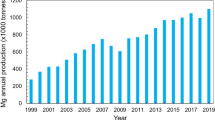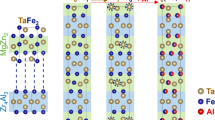Abstract
The intermetallic compounds NiTi, NiTi2, CuZr, CuTi2, and Zr3Al were irradiated by 2 McV protons at various temperatures between –175 °C and –44 °C to a fluence of 1.9 × 1022 H+/m2. Transmission electron microscopy, electron diffraction, and x-ray diffraction were used to evaluate the extents of disordering and amorphization induced by irradiation in the samples. Both phenomena progressed to varying extents in the five compounds, depending on the irradiation temperature and dose. It was observed that the C-A transition began before the degree of long-range order was reduced significantly, and that the amorphous phase nucleated homogeneously throughout the crystalline matrix. A major finding of the current investigation is that the technique of scanning electron fractography provides a useful correlation between the features of the fractured surfaces and the microstructural alterations induced by the proton irradiations. When amorphization is complete the fracture surfaces are either featureless (e.g., NiTi2) or contain branching features resembling river patterns. In some cases (especially in CuZr) these are similar to the markings seen on the surfaces of fractured amorphous ribbons produced by melt-spinning. In general, however, there is not a particularly good correlation between the features on the fracture surfaces of the irradiated and melt-spun ribbons. When the microstructure consists of amorphous regions embedded in a partially disordered crystalline matrix, there is considerable evidence for irradiation-induced ductility. In such cases, exemplified by the results on NiTi and Zr3Al, the fracture surfaces contain dimples, characteristic of ductile fracture, suggesting that disordering promotes ductility.
Similar content being viewed by others
References
J. Bloch, J. Nucl. Mater. 6, 203 (1962).
J. Brimhall, L. A. Chariot, and R. Wang, Scripta Metall. 13, 217 (1979).
M. D. Rechtin, J. B. Vander Sande, and P. M. Baldo, Scripta Metall. 12, 639 (1978).
C. F. Cline, R. W. Hopper, and W. L. Johnson, Proc. 4th Int. Conf. on Rapidly Quenched Metals (Sendai, 1981), p. 775.
D. Lesueur, Rad. Eff. 24, 101 (1975).
W. G. Johnston, A. Mogro-Campero, J. L. Walter, and H. Bakhru, Mater. Sci. and Engr. 55, 121 (1982).
B. Bethune, J. Nucl. Mater. 31, 197 (1969).
D. G. Walker, J. Nucl. Mater. 37, 48 (1970).
D. G. Walker and P. A. Morel, J. Nucl. Mater. 39, 49 (1971).
R. O. Elliott and D. A. Koss, J. Nucl. Mater. 97, 339 (1981).
L. M. Howe and M. H. Rainville, J. Nucl. Mater. 68, 215 (1977).
L. M. Howe and M. H. Rainville, Rad. Eff. 48, 151 (1980).
G. Thomas, H. Mori, H. Fujita, and R. Sinclair, Scripta Metall. 16, 589 (1982).
H. Mori and H. Fujita, Japan J. Appl. Phys. 21, L494 (1982).
D. E. Luzzi, H. Mori, H. Fujita, and M. Meshii, in Beam-Solid Interactions and Phase Transformations, edited by H. Kurz, G. L. Olson, and J. M. Poate, Proc. of Symp. A of the MRS Fall Meeting, Boston, MA, Dec. 2–4, 1985.
D. E. Luzzi, H. Mori, H. Fujita, and M. Meshii, Acta Metall. 34, 629 (1986).
H. Mori, H. Fujita, and M. Fujita, Japan J. Appl. Phys. 22, L94 (1983).
P. Moine, J. P. Riviere, M. O. Ruault, J. Chaumont, A. Pelton, and R. Sinclair, Nucl. Instr. and Methods in Phys. Res. B7/8, 20 (1985).
D. E. Luzzi, H. Mori, H. Fujita, and M. Meshii, Scripta Metall. 18, 957 (1984).
D. E. Luzzi, H. Mori, H. Fujita, and M. Meshii, Scripta Metall. 19, 897 (1985).
H. Mori, H. Fujita, M. Tendo, and M. Fujita, Scripta Metall. 18, 783 (1984).
J. W. Dim and H. R. Johnson, Plat. & Surf. Fin. 68 (10), 64 (1981).
J. P. Biersack and L. H. Haggmark, Nucl. Instr. and Methods 174, 257 (1980).
D. Lee, J. Cheng, M. Yuan, C. N. J. Wagner, and A. J. Ardell, J. Appl. Phys. 64, 4772 (1988).
C. N. J. Wagner, D. Lee, M. S. Boldrick, J. Cheng, C-S. Lee, and A. J. Ardell, J. Non-Cryst. Solids 106, 81 (1988).
B. D. Cullity, Elements of X-Ray Diffraction (Addison-Wesley, Reading, MA, 1971).
J. S. Huang and E. N. Kaufman, J. Mater. Res. 3, 238 (1988).
Author information
Authors and Affiliations
Rights and permissions
About this article
Cite this article
Cheng, J., Yuan, M., Wagner, C.N.J. et al. Fractographic fingerprinting of proton-irradiation-induced disordering and amorphization of intermetallic compounds. Journal of Materials Research 4, 565–578 (1989). https://doi.org/10.1557/JMR.1989.0565
Received:
Accepted:
Published:
Issue Date:
DOI: https://doi.org/10.1557/JMR.1989.0565




